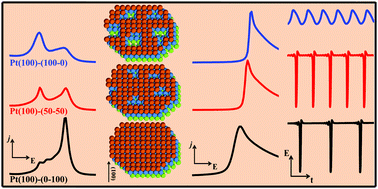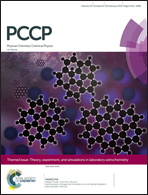Probing the surface fine structure through electrochemical oscillations†
Abstract
In the course of (electro)catalytic reactions, reversible and irreversible changes, namely the formation of adsorbed poisons, catalyst degradation, surface roughening, etc., take place at distinct time-scales. Reading the transformations on the catalyst surface from the measurement of the reaction rates is greatly desirable but generally not feasible. Herein, we study the effect of random surface defects on Pt(100) electrodes toward the electro-oxidation of methanol in acidic media. The surface defects are gently generated in situ and their relative magnitudes are reproducibly controlled. The system was characterized under conventional conditions and investigated under an oscillatory regime. Oscillatory patterns were selected according to the presence of surface defects, and a continuous transition from large amplitude/low frequency oscillations (type L) on smooth surfaces to small amplitude/high frequency oscillations (type S) on disordered surfaces was observed. Importantly, self-organized potential oscillations were found to be much more sensitive to the surface structure than conventional electrochemical signatures or even other in situ characterization methods. As a consequence, we proved the possibility of following the surface fine structure in situ and in a non-invasive manner by monitoring the temporal evolution of oscillatory patterns. From a mechanistic point of view, we describe the role played by surface defects and of the adsorbed and partially oxidized, dissolved species on the oscillations of type S and L.

- This article is part of the themed collection: 2018 PCCP HOT Articles


 Please wait while we load your content...
Please wait while we load your content...